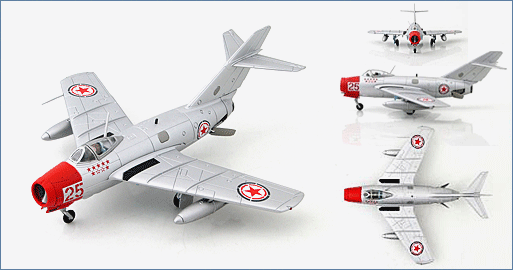Air Power Series>1:72 die-cast display model>MIG-15>HA2418
MIG-15bis No. 25, Chinese People Volunteers Air Force, North Korea, 1950s

General Background
The MiG-15 (NATO name Fagot) was designed from information and technology gathered from captured WWII Germans. The main features of the Mig-15 were its simplicity and swept wings. The MiG-15bis was an improved single-seat fighter with better cannon, fuel capacity, avionics and a Klimov turbojet engine developed using an unlicensed Rolls-Royce Nene engine. All this was put in a strengthened airframe. The Allies were completely surprised when the Mig-15 arrived in Korea and quickly brought about the development of the F-86 Sabre.
The Aircraft
The Mig-15 entered the Korean War in November 1950 flown by Soviet pilots because the
North Korean and Chinese were still being trained on this aircraft. The CPVAF was created in
September 1950. It wasn’t long into the war when it was felt they had been trained enough and
the Soviet pilots were withdrawn and replaced with North Korean volunteer pilots. The Mig-15
came as a complete shock to the UN Forces so they hurried the F-86 into production to counter
the MiG.
Specifications :
| Country of origin: | Russia |
| Manufacturer: | Mikoyan-Gurevich |
| Role: | fighter/interceptor |
| Crew: | 1 X pilot |
| Performance | |
| Engine: | 1 X 5,952 pound thrust Klimov VK-1 turbojet |
| Maximum Speed at Sea Level: | 668mph (1,075km/hr) |
| Ceiling: | 50,855ft. |
| Range: | 1,156miles (1860km) |
| Weight | |
| Emptyt: | 8,115lbs. (3,681kg) |
| Max Takeoff: | 13,327lbs. (6,045kg) |
| Dimensions | |
| Wing Span: | 33ft. 0.75in. (10,08m) |
| Length: | 35ft. 7.5in. (10,86m) |
| Height: | 12ft. 1.75in. (3,70m) |
| Armament: | 1 X 37-mm N-37 cannon |
| 2 X 23-mm NS-23 or NR-23 cannon | |
| Up to 1,100 pounds of mixed stores on under-wing hard-points |

